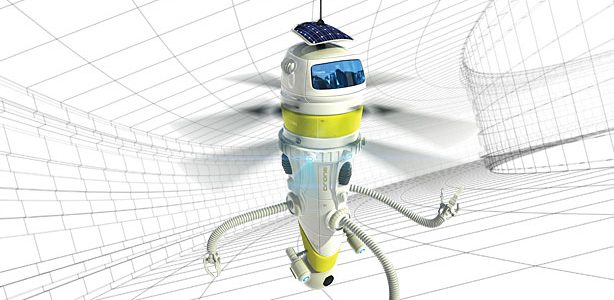As drone advancements accelerate, experts weigh in
In just a few years, multirotor technology has rapidly advanced to the point where these stable machines are being flown in backyards and businesses around the globe. Applications as varied as agriculture, wildlife conservation, search and rescue missions all benefit from adding multirotors to their resources. A few more years from now, where else will multirotors be used, and how will they change? We talked to a few experts to find out where they see rotor drone technology going over the next several years, and here are their predictions.
OUR PANEL OF EXPERTS
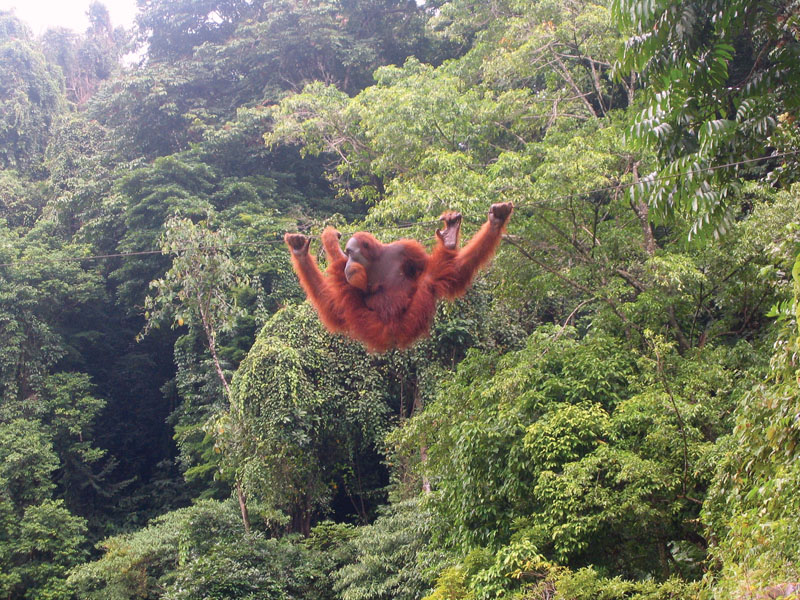
Quiet, compact drones can monitor endangered species like the orangutan in remote areas without disturbing the animals.

After Capt. Moore discovered the “Great Pacific Garbage Patch,” he returned with multirotors to find and measure additional patches of floating debris.
ENVIRONMENTAL
In the next five to 15 years, environmental conservation drones will play significant roles in protecting wildlife, spotting poachers and tracking forest loss. In some parts of the world where the restrictions on flying drones for commercial purposes are far less than in the U.S., these efforts are already happening. Although it’s still the “dawn of drone ecology,” as one innovator calls it, these unmanned aerial vehicles are already skimming over Indonesia’s jungle canopy to photograph orangutans, protecting rhinos in Nepal and South Africa, and studying invasive species of aquatic plants in Florida. The Sumatran Orangutan Conservation Program is testing drones over Indonesia’s Tripa peat forest where fires set by palm oil growers are threatening the world’s highest density habitat of the great apes. One drone team associated with UVU sent a team to Nepal to map the areas of destruction. There will be more organized efforts in the future stemming from NASA and other large and well-funded organizations, many of them private. A UVU graduate from our certificate program is using his knowledge for anti-rhino-poaching in South Africa.
—John Minor, UVU Provost
RadFlight had the privilege of working with Captain Charlie Moore who discovered the “Great Pacific Garbage Patch” back in 1997. Capt. Moore and his crew decided that drones were a valuable tool, and he wanted to add them to his arsenal in order to locate and measure the plastic masses that are a part of the larger garbage patch. They were able to get aerial shots of the “plastic soup” that had never been seen before. RadFlight is working with NOAA to develop a research VTOL drone that can take off and land on a moving ship. This will take the range of drones and their visual capabilities beyond where they can currently go. NOAA is currently using drones for monitoring whale populations.
—Mike Rivard, RadFlight Inc. Founder/CEO
Imagine a swarm of insect-sized multicopters patrolling forests, each armed with a different type of sensor package: Infrared, ultrasonic, even sniffers to monitor pheromones in the environment. These swarms can detect embers before they’d turn into fire, detect distressed animals and hikers for rescue, monitor environmental conditions from dew points to CO2 concentrations. They could even potentially monitor fault lines for stress on constant patrol to give warning. Having worked at California Academy of Sciences for four years, and in talking with some of the world’s finest scientists, believe me, this isn’t science fiction. The scientific possibilities with multicopters and swarming are truly astounding. I believe if people can get past their fear of multicopters, these applications—and many more—aren’t even very far around the corner.
—Ty Audronis, President Audronis Media
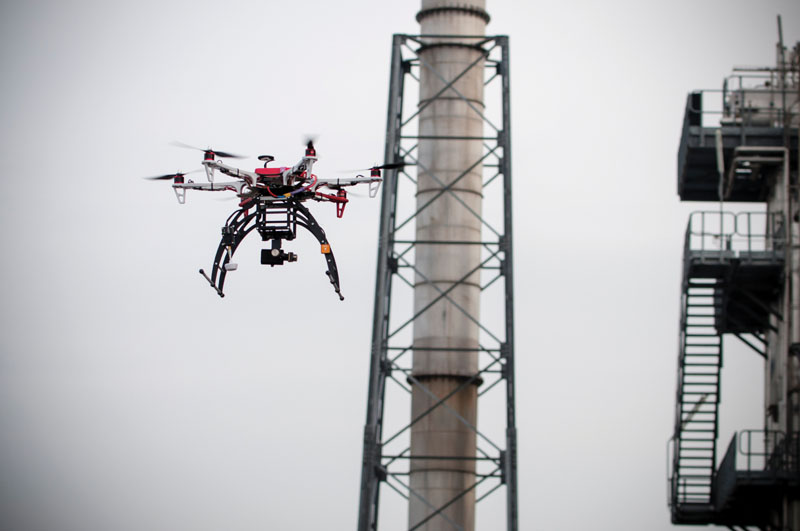
Inspecting tall structures like bridges and oil rigs is easier and faster with camera-equipped multirotors than using manpower.
INFRASTRUCTURE
This area highlights where drones can do the job more effectively and more efficiently than the human being. According to a recent report from the White House, one in four bridges in the United States are in dire need of significant repair, or cannot handle automobile traffic. Typically, when bridges are inspected for defects, such as cracks, engineers must use hanging scaffold systems or view them from elevated platforms. It’s a slow, dangerous, expensive process and even the most experienced engineers can overlook cracks in the structure or other critical deficiencies. In the long run, drones could prove to be a far more cost-effective option because not only would they make bridge inspection safer, they would also potentially detect damage much earlier. University engineers are already employing wireless sensors and drones that may soon be able to examine the condition of bridges in a quicker, more efficient manner. Similar technology can be applied to any kind of infrastructure inspection. Over the next five to 15 years there will almost certainly be many new start-up service companies developed to conduct these inspections based on drone technology. Drones will become a standard piece of equipment for inspectors, engineers, consultants … every part of this industry. We envision existing companies employing many land surveyors and inspectors adding drones to the “toolbox” to make their companies more profitable, but to also provide a better service to their customers.
—John Minor, UVU Provost
Multicopters could be immensely invaluable in this aspect of daily living. Within five years, I’d expect to see multicopters equipped with sensor packages to detect things such as stress fractures inspecting some of the larger bridges around the country. In 10 years, multicopters will be executing minor repairs. In 15 years, it would be amazing to see automated service of our infrastructure to completely manage bridges, power lines, even pick up the slack for communication in the event of an outage with onboard signal repeaters.
—Ty Audronis, President Audronis Media
Wind farms will benefit from having a safer way to inspect blades. Solar farms will benefit from having thermal cameras to inspect for early problems, saving many hours of manpower to inspections. Multicopters will be used to inspect bridge and power lines, oil rigs, and a multitude of other applications.
—Dan Willyerd, Director of Sales, Monarch Inc.

U.S. Coast Guardsmen assigned to the coastal patrol boat USCGC Haddock count bales of marijuana aboard a seized panga in the Pacific Ocean off the coast of southern California.
PUBLIC SAFETY
The ability to arrive on a scene and to be able to “see” the entire situation from an aerial view is a tremendous advantage to public safety command and control operations. This will lead to saved lives. In addition to the local responders seeing the image, there will be capability to stream the video anywhere in the world over the internet, connecting to the expert for a particular situation; think hazmat subject matter expert, hostage crisis scenario, structural engineering following a disaster such as a major earthquake, tornado damage, bio-chemical incident, nuclear incident, etc. The ability to stream live video can assist these subject matter experts with making professional assessments on how to best handle the situation on the ground. There are large private security firms that are already rapidly adopting and deploying unmanned aerial systems in third world countries.
—John Minor, UVU Provost
Disaster relief and public safety industries will be two of the biggest beneficiaries 10 to 15 years down the road. I see a fleet of UAVs assisting in all search and rescue missions, eventually replacing helicopters. There will be UAVs equipped with infrared, thermal and night-vision cameras, all functioning without pilots. Others will have the ability to automatically track where missing people are and deploy defibrillators, food/water, medicine etc.
—Michael Shabun, DJI, Marketing Manager
RadFlight has been working on a solution for the U.S. Coast Guard, the Port of Long Beach and the Long Beach Police Department for drones to be used for Panga interdiction. Pangas are small, very fast boats that smuggle drugs and people along the Southern California Coast. At the present time, the only way the Coast Guard can determine if a small boat is a smuggler or a fisherman is to send a boat out to check them out in person. We see a time when long range “wings” will fly in broad solar-powered swarms that will monitor the coast on a 24-hour basis.
—Mike Rivard, RadFlight Inc. Founder/CEO
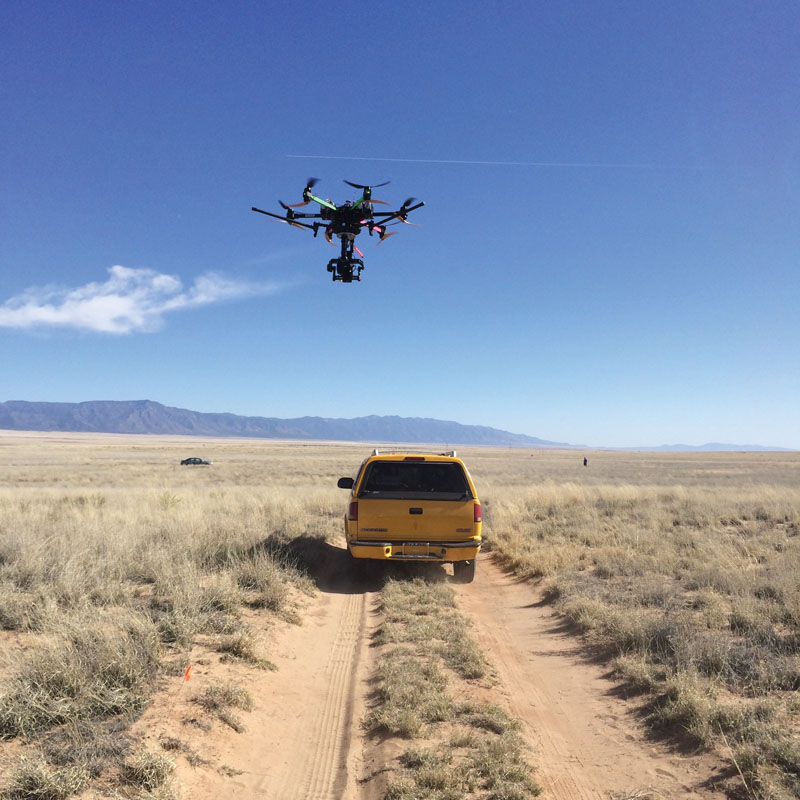
Aerial cinematography outfits like AeroCine use drone-mounted cameras to film action sequences like this car chase in New Mexico more safely and more affordably than a manned aircraft could.
MEDIA & FILM
Having been in the movie and commercial production business for a few years, I believe that within five to six years we will see a drone on every movie and major production set just as we see cranes and steadicams on every set today. The creativity factor of using a camera drone is still being discovered by directors and cinematographers. The more they use the drone as a cinematic tool, the more creative and complex the shots will become. Drones open a complete other dimension to filmmakers and producers that they are just beginning to discover.
—Mike Rivard, RadFlight Inc. Founder/CEO
Over the next five years or so, most films will have some sort of remote aerial cinematography. As the technology continues, the shot design and execution of aerials will become easier for the operators and in return the shots will be able to break new ground in shot design.
—Matthew Mosher, Aerial DP, Sky Bandit Pictures
You’re going to see the playing field level off between the content professional photographers/cinematographers have been able to capture for big budget productions and what independent filmmakers are trying to achieve. Big cranes and pricey helicopter shots will be replaced by a skillful pilot flying a UAV from the ground. You might even see a majority of on ground cameras be replaced with cinema-quality cameras rigged onto UAVs. And who knows, custom silent drones might even be created for Hollywood that can capture audio as well.
—Michael Shabun, DJI, Marketing Manager
I really don’t see much changing on these fronts. Of course things will get smaller, and guidance systems will get even smoother. Other than maybe swarming technology helping with lighting (maybe multicopters equipped with lighting), and special effects sequences (motion capture on set, floating “bullet-time” arrays, etc.), the fact that this industry has been the main driving force in the multicopter industry means that (most) of the possible uses have already been imagined and at least tested.
—Ty Audronis, President Audronis Media
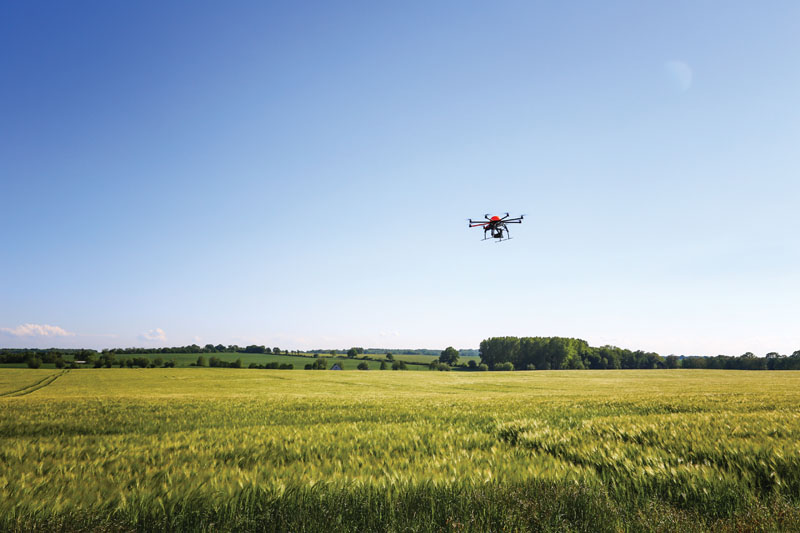
Perhaps the most important way drones can improve our lives is in making agriculture more efficient and cost-effective.
AGRICULTURE
The U.S. is currently behind the Japanese and other countries in implementing “precision agriculture” into our agricultural landscape. The AUVSI predicts that 80% of drone use will be for agricultural use in one form or another. We are working with major agricultural companies in the Fresno, California area to introduce “swarm” technology and how we can utilize this approach to monitor and scout crops for various signs of distress. A drone equipped with infrared cameras can take a close look at the health of plants to help growers determine whether they need water, are suffering from insect infestation or need additional fertilizer. As we get this equipment in the hands of our farmers, we can increase crop yield using less water, pesticides and fertilizer. Future uses could include: planting, crop sampling, spraying of pesticides and fertilizer, and maybe someday harvesting. Drones allow the farmers to finally have data that they can utilize to increase their yields. As one expert said, “Agriculture is a big data problem without big data,” but drones can change that dramatically.
–Mike Rivard, Founder/CEO Radflight
Agriculture will benefit from having a quicker and less expensive way to have precision 3D mapping, multi spectral images to ensure crop health, monitor irrigation, and spot pests and invasive weed growth; All increasing yields and reducing cost.
—Dan Willyerd, Director of Sales, Monarch Inc.
I think line beyond visual line of sight will become commonplace in agriculture. There is a huge market for precision agriculture, which is where you fly your drones over your field and it tells you everything from where you need to water to where you need to apply pesticides or herbicides. The chemicals used in farming are expensive, so reducing the amount that you need to put down is both cost-effective and environmentally friendly. Even small farms cover 25 to 30 square miles, so a person flying visual line of sight can only cover a very small portion of that and would have to take down and set up their flight operation many times. The FAA realizes this and is looking into ways to make flying beyond visual-line-of-site a safe process so that in five years it will be commonplace.
—James Williams, former Unmanned Aircraft Systems Executiv, FAA
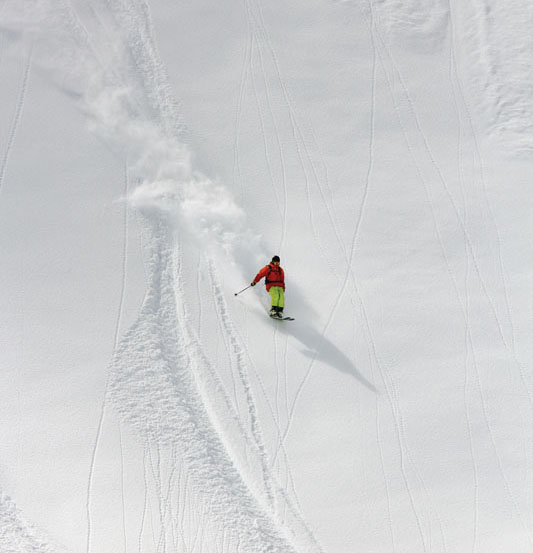
Soon, action sports enthusiasts everywhere will be using drones to take selfies during their stunts!
RECREATION
With the ever-increasing spread of social media and YouTube, I expect an explosion in content and an ever-increasing quality of video from the casual user in the next five years. Looking farther down the road, 10 years and beyond, I see smaller markets and more specialized multirotors becoming defined. An example of a current specialized market is the 250mm FPV racer. Perhaps this will extend to additional sport and competitive markets. I think regulations will also shape the multirotor culture as to what size, payloads, and areas can be flown legally and safely.
—David McCallister, Hobbico R&D Manager, Electronics
Drones, multirotors, quads, or whatever you call them, it’s clear that the everyday consumer has started to latch on to this technology. Now, more than ever we are seeing the everyday family making a “drone” purchase. Why buy a hand-held recorder when you own a smartphone? Why not spend that money on something that can make your family video that much more epic! In the next few years, we will see even more adoption rates on this aerial media technology and the use of these products will become more and more accepted.
—Steve Petrotto, Horizon Hobby, Brand Manager
The way the industry as a whole is heading, you’re going to see some phenomenal advancements in autonomous flight, camera quality and personalization. If I was a firefighter, a farmer, a snowboader or a number of other professionals and hobbyists who are starting to incorporate UAVS, I’d be really excited. These guys are going to have a hardware and software developed that caters to their professions.
—Michael Shabun, DJI, Marketing Manager
Things on this front are going to blow people’s minds. Being able to survey a mountain bike route, hiking route, or have your multicopter follow you down (or up) the mountain—just incredible possibilities. Just the other day a friend was asking me if he can have a drone follow him while he’s surfing. Believe it or not, the possibility of this already exists. I imagine a future where a micro-multicopters are the new personal assistant, just as common as iPhones. Remember “Bit” from the original Tron? A tiny multicopter that answers your questions, acts as a hot spot, warns you of danger around the corner … the possibilities are limitless!
—Ty Audronis, President Audronis Media
CHALLENGES
The drone industry needs the FAA to develop and implement the rules and regulations for commercial use of drones. One day drone operators with the proper education, experience, training, and certifications should be able to “file and fly” just like is done in manned commercial aviation. A second major challenge is educating the public that drones are good! They can make businesses and non-profit organizations more efficient and cost effective by replacing human beings and manned aircraft. Studies have shown that there is still a lot of fear by the public that drones will be crashing everywhere or used for unlawful purposes. Drone technology has improved significantly and will continue to improve over the next five to 15 years. Multirotor drones have a safety record that is at least as good as or better than manned helicopters.
—John Minor, UVU Provost
The ongoing lack of clear direction or policy from the FAA. The 333 Exemption is one step in the right direction, but we still need concrete guidance and policy making to free the drone operators to work and private companies to hire them.
—Mike Rivard, Founder/CEO Radflight
Current drones are fairly barbaric compared to where they will be five to 10 years in the future, and I don’t think that the biggest challenges will be technical. The biggest challenges are likely going to be on cultural and regulatory fronts.
—Eric Cheng, DJI Director of Aerial Imaging

Will drones of the future have batteries that allow them to stay airborne for extended periods? The experts say yes!
DREAM FEATURES
I’d like to see a multirotor that can stay in the air for much longer periods of time and have a longer range to assist rescue worker and emergency responders.
—Michael Shabun, DJI, Marketing Manager
From a technology point of view, we will see increased user friendliness, better camera systems and longer flight times. User-friendliness is the biggest piece of the puzzle in my opinion.
—Steve Petrotto, Horizon Hobby, Brand Manager
I would like to see airbags for protection of people and gear in the unfortunate event of a power failure.
—Matthew Mosher, Aerial DP, Sky Bandit Pictures
I would like to see easy-to-fly, crash-proof multirotors that know where and when they can fly legally and safely.
—Eric Cheng, DJI Director of Aerial Imaging
If the batteries and motors can be significantly improved to offer flight times comparable to fixed-wing drones, this advance in the technology would be huge for the multirotor industry. In addition, alternative propulsions systems can be looked at that will provide more range and endurance.
—John Minor, UVU Provost
Dream features include a transponder that will have the owner’s I.D. on it and a black box that will record all the flight data. Hopefully this will be the first step in managing the unsafe and careless flights that some of the drone enthusiasts have been doing. When a drone flies too close to a commercial airliner, I think we should know who owns that drone and where they’re flying from.
—Mike Rivard, RadFlight Inc. Founder/CEO
The ability to track a cell phone would be awesome. Imagine putting a cell phone in an actor’s pocket and having your multicopter with the camera automatically track that person? That would be liquid awesome.
—Ty Audronis, President Audronis Media
The technologies that I hope will tackle challenges to multirotors are collision avoidance and a smarter airspace. Collision detection technology could prevent collisions that result in property damage and injury while reducing the pilot’s burden. Airspace management technology should allow manned and unmanned aircraft of all sizes to safely navigate and use our airspace. Smaller and cheaper ADS-B transponders and projects like the NASA UTM (Unmanned Traffic Management) are hopefully leading us to these goals.
—David McCallister, Hobbico R&D Manager, Electronics
In five years, drones will be standard equipment in aerial imaging and survey across all relevant industries. They will be legally and safely integrated into low-altitude airspace for both recreational and commercial use, except perhaps in a few nations that have philosophical or geopolitical reasons for keeping them out. In 10 to 15 years, small drones could become ubiquitous as aerial payload delivery systems not restricted only to imaging. They could, in acceptable regions, also safely be integrated into manned airspace.


